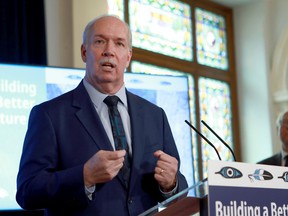Opinion: While five-year plan has some specific, easy to measure, proposals, expect some of the commitments to show up in plan after plan after plan

Article content
VICTORIA — The New Democrats have finally released their plan for implementing the UN Declaration on the Rights of Indigenous Peoples in BC, 2½ years after the enabling legislation passed unanimously in the provincial legislature.
Advertisement 2
Article content
The legislation required the government to produce a plan for reconciling provincial policies, laws and programs with UNDRIP’s 46 principles on Indigenous rights, laws, and culture.
Scott Fraser, then the minister for Indigenous relations, said in November 2019 that the plan would be completed “within months, not years.”
Then came the pandemic, delaying the required-by-law consultations with First Nations.
The government did manage to pull together a draft version of the plan last June, but the year’s wildfires and floods occasioned further delays.
On Wednesday, Premier John Horgan and the current minister, Murray Rankin, released the first five-year plan, with some 89 items targeted for action between now and 2027.
advertisement 3
Article content
The plan did not lack for ambition, touching as it did on pretty much every area of public policy and every ministry of government.
Some examples:
• “Establish a new institution designed and driven by First Nations to provide supports to First Nations in their work of nation- and governance-rebuilding and boundary resolution in accordance with First Nations laws, customs and traditions.”
• “Prioritize implementation of the First Nations justice strategy to reduce the substantial overrepresentation of Indigenous peoples involved in and impacted by the justice system.”
• “Conduct an external review of Indigenous-specific racism and discrimination in the provincial public education system, and create a strategy, including resources and supports, to address findings.”
advertisement 4
Article content
• “Co-develop with Indigenous peoples a new distinctions-based fiscal relationship and framework that supports the operation of Indigenous governments, whether through modern treaties, self-government agreements or advancing the right to self-government through other mechanisms.”
The reference to “distinctions-based” fiscal relationships in the latter item highlights another challenge to implementation.
“The province is committed to a distinctions-based approach,” the plan reads in part.
“This requires that the province’s dealings with First Nations, Métis and Inuit peoples be conducted in a manner that acknowledges the specific rights, interests, priorities and concerns of each, while respecting and acknowledging these distinct peoples with unique cultures, histories, rights, laws , and governments.
advertisement 5
Article content
“All Indigenous peoples have human rights that are expressed in the UN Declaration. However, not all rights are uniform or the same among or between all Indigenous peoples. In many cases, a distinctions-based approach may require that the province’s relationship and engagement with First Nations, Métis and Inuit Peoples include different approaches or actions and result in different outcomes.”
No small order, considering that BC has some 200 recognized First Nations, more than there are member states in the UN.
The release was marked by twin ceremonies at the legislature, one in the hall of honor outside the chamber and the second on the floor of the house.
Premier John Horgan donned his historian’s hat for the occasion, calling the plan a road map “to do what has never been done on planet Earth before.”
advertisement 6
Article content
First nations leaders and party representatives all praised the plan as a well-intentioned start, and it surely was that.
But was it more than that?
Rankin disputed that the contents were mostly “aspirational.”
On the contrary, he insisted, it consisted of “specific, tangible, measurable actions.”
“There are things you can really get your arms around and do within the five-year period,” he told reporters.
Well, yes and no.
Some of the 89 items were sufficiently specific to meet the Rankin test, like the vow to ensure that every First Nations has high-speed internet services.
But there were also many commitments along the lines of “develop an approach,” “update an agreement,” “recognize a role,” and “draft a report.”
advertisement 7
Article content
Rankin’s own ministry is directed to “complete and implement government-to-government agreements that recognize Indigenous self-government and self-determination.”
The plan doesn’t say how many of those should be concluded in the first five years.
There’s also a commitment to “review existing provincial mandates to enhance treaty and self-governing nations’ fiscal capacity to deliver services to their citizens.”
Nothing about what is to be done once the review is completed.
Perhaps Rankin was thinking of commitments like those when he admitted “some of it will not be done for a generation.”
The premier was closer to the mark when he said, “we have a long way to go.”
The plan itself says that “progress will be reviewed on an annual basis and publicly reported in an annual report that will be prepared in consultation and cooperation with Indigenous peoples and submitted to the BC legislature by June 30 each year.
advertisement 8
Article content
“The action plan will be comprehensively updated within five years.”
Come 2027, expect the government of the day to produce another five-year plan and another one after that.
When NDP MP Romeo Saganash put forward the first UNDRIP legislation in the federal parliament a few years back, he envisioned a 20-year timeline for reporting progress on his version.
BC, in adapting some of Saganash’s provisions, dropped the 20-year timeline after some First Nations complained and instead went with the rolling five-year plan.
But given what is being attempted here, the Saganash timeline strikes me as realistic and maybe overly optimistic.
Even with the best intentions and much effort and funding, fulfillment of the BC government’s plan will take decades.
More news, fewer ads, faster load time: Get unlimited, ad-lite access to The Vancouver Sun, The Province, National Post and 13 other Canadian news sites for just $14/month or $140/year. Subscribe now through The Vancouver Sun or The Province.